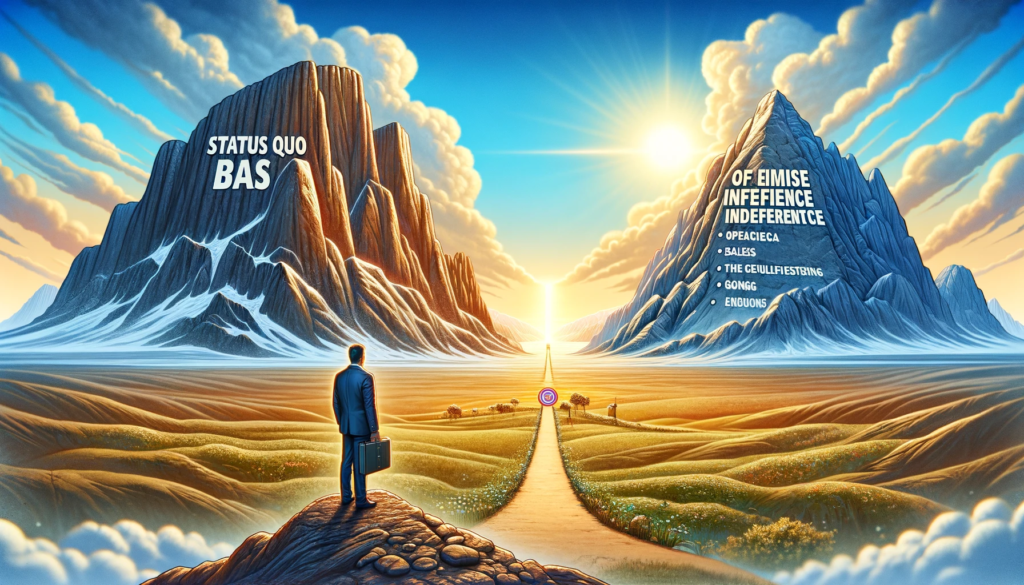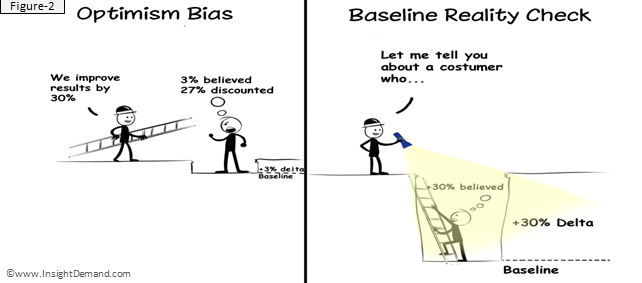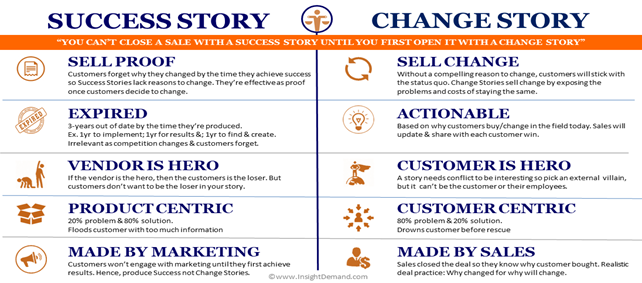
The value to buy your product is overwhelming and yet the customer decides not to buy. At times like these, it’s important to remember that customers are not rational decision making machines. They are human beings with built in cognitive biases that make them highly resistant to change. The status quo and optimism biases, for example, prevent customers from making the sensible decision to buy your product. To sell change, salespeople must not only climb a mountain of fear to get past the status quo bias, but they must also cross a valley of indifference to overcome the optimism bias. This is why selling change is so difficult.
Until salespeople improve at opening the gap with “WHY CHANGE,” they will struggle to close the gap with “WHY US.” Without a compelling reason to change, customers will stick with the status quo and “no decision” will continue to be your biggest competitor. To help customers buy, salespeople need Change Stories and Questions so that they can inspire customers to step into growth instead of back into safety.
STATUS QUO & OPTIMISM BIAS BLOCK CHANGE
The status quo bias is a prison that locks the customer in no decision. It’s built in the customer’s mind on a foundation of the fear of change. If customers put the status quo and new products on the evaluation shelf when they evaluate new products, then these prison walls wouldn’t exist, because the risk of status quo would counteract the risk of change. But customers are biased. They hold the status quo close to their heart, and only put new products on the shelf (see figure-1). As a result, they neglect to evaluate the risk of the status quo. This is a problem because the risks of change are real, and include such factors as: Implementation risk; ramp up time learning a new product; career risk if the product fails; financial risk if the ROI isn’t achieved; risk of being misled, and; risk of being exposed for not doing your job properly. No wonder customers build a wall around the status quo to protect them from change.
Even if the benefits of the seller’s product make it past the customer’s defensive wall, customers will discount the seller’s claims for gains. Why? The optimism bias inflates the customer’s baseline, so customers don’t believe their results can be improved (see figure-2). This is a well-documented cognitive bias where individuals overestimate their own abilities relative to others. Do you, for instance, feel you are an above average driver? I know I do, and so do 93% of surveyed US drivers. This is why telling customers your product will improve their results by 30% rarely works, because most of the time, customers just don’t feel like they have a problem. Until salespeople learn to hold up a mirror to the customer’s unexamined problems, customers will continue to have an inflated baseline. So salespeople should not be surprised when customers say their product may be great for someone else, but not for them.
KILL THE STATUS QUO & OPTIMISM BIAS WITH INSIGHT
Because of these biases, customers not only neglect to assess the risk of the status quo, but they also inflate their baseline. This creates pockets of unrecognized value for change that customers don’t see. More important, it provides the opportunity for sellers to shine the light of insight on the root causes of the customer’s negative biases so that they can expose these unrecognized pockets of value. By working backwards from their product, sellers can create these insights by showing the problems, costs, and risks to the customer’s business in the absence of having the seller’s unique capability.
KILL THE STATUS QUO BIAS: By performing a risk assessment of the status quo, customers will be motivated to change because they will realize that the risk of the status quo is now greater than the risk of change (see Figure-1).
KILL THE OPTIMISM BIAS: By performing a baseline reality check, customers will be motivated to change and ready to be rescued by the seller’s product , because customers will discover they are no longer ankle deep in problems but out in the middle of the lake drowning in problems (see Figure-2).
DELIVER INSIGHT THROUGH CHANGE STORIES & QUESTIONS
It’s difficult to deliver the message that customers are not operating optimally without getting a black eye. To protect their self-esteem and guard themselves from the risk of change, the buyer’s confirmation bias motivates them to select evidence in favor of the status quo or reject evidence supporting change.
So instead of trying to force insights through the buyer’s defensive wall, sellers should deliver their message via a story, because they’re about someone else so they are nonthreatening (see figure-3). Without feeling attacked, customers can now relax and take in the seller’s story. And if the story is insightful enough, they may start to tell themselves a new story where new choices make more sense. So put your change message inside a story and, like a Trojan horse, it will make it over the customer’s defensive wall.
RESETS THE STATUS QUO AUTOPILOT WITH CHANGE STORIES
Change messages don’t just need to make it over the customer’s defensive wall; they must also reset the customer’s automatic pilot. How many times have we read a self-help book and still not made any changes? For the most part, people don’t change unless they experience a crisis or an insight that sinks so deep it speaks to the subconscious and resets the autopilot. Change Stories can manufacture a crisis and deliver insight so that we can reset the customer’s automatic pilot. Because Change Stories don’t just speak to the conscious mind, they also speak to the gut. They are experiential. They virtually transport customers to a concrete point in time when another customer realized the status quo was broken and could no longer be duct taped together. Suddenly, your prospective customer realizes that their problem is bigger and riskier than they previously thought and they now need to change. (see my HBR article When to Sell with Facts and Figures, and When to Appeal to Emotions).
CHANGE STORIES MUST BE MADE BY SALES
You can’t rely on your marketing team to produce change stories, because new customers won’t engage with marketing until they achieve results. When they finally do achieve result, customers will have either forgotten why they decided to change or the competitive landscape would have changed so much that the reasons they changed are no longer relevant.
Salespeople, on the other hand, already know why customers bought, because they won their business in the first place. Customers are also more likely to share the reasons they changed privately with salespeople because they will have already established a trusting relationship.
Sales can create this content by having each salesperson record his or her key customer wins as Change Stories. This is a useful exercise because salespeople use the same skillset to uncover why a past customer bought as they do to determine why a future customer will buy. Not only will peer feedback improve each individual story, the group will also gain from their pooled knowledge when Change Stories are shared in sales meetings.
Once sales have convinced customers that they’re drowning with change stories, sales can then use success stories as proof to convince the customer that their product will rescue them (see Why Sales Fails at Selling Change with Success Stories).
LEARN HOW TO CREATE CHANGE STORIES & QUESTIONS
To implement this strategy, it is critical for salespeople to improve their storytelling skills. They must learn to share only the essence of why a customer changed or bought. If they include everything that happened in the deal, they’ll drown out the message. Sales will also need to know how to convert their stories into discovery questions so that salespeople can alternate between sharing stories and asking questions during a call, just like in a natural conversation.
In conclusion, we’ve shown why selling change is so difficult, because salespeople must not only climb a mountain of fear to get past the status quo bias, they must also cross a valley of indifference to overcome the optimism bias. This is why selling change is so difficult. Until salespeople improve at opening the gap with “WHY CHANGE,” they will struggle to close the gap with “WHY US.” Without a compelling reason to change, customers will stick with the status quo and “no decision” will continue to be your biggest competitor. To help customers buy, salespeople need Change Stories and Questions so that they can inspire customers to step into growth instead of back into safety.





